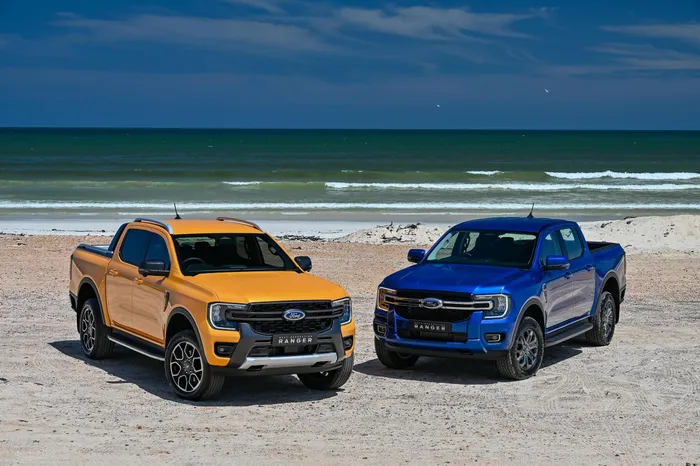May vehicle sales wrap: 50 top selling vehicles and expert insights after buoyant month

The Ford Ranger edged closer to Toyota's Hilux in May, after its sales grew by 24%.
Image: Supplied
South African new vehicle sales rode a wave of optimism in May, with the market growing by a significant 22% year-on-year, according to Naamsa.
Although sales were relatively slow during the first half of May, there was a significant uptick during the second half of the month, the National Automobile Dealers’ Association (NADA) reported. This came in the wake of the 2025 Budget being finalised, as well as President Cyril Ramaphosa’s meeting with US President Donald Trump and the interest rate cut.
Passenger car sales, at 31,741 units, surged by 30% versus the same month in 2024, while light commercial and bakkie sales increased by a more modest 5.8%.
On the sales charts, bakkies took the top two spots.
The Toyota Hilux led overall with 2,548 sales, a decline of 8.3% versus the previous month, while the Ford Ranger took second spot overall with 2,147 sales, an impressive gain of 24.2%.
Third overall, and leading the passenger car sector was the Suzuki Swift at 1,842 units, albeit down by 11.4% over April, while the Toyota Corolla Cross retained fourth position with its volume of 1,629, an increase of 2.8%.

The Suzuki Swift was once again Mzansi's most popular passenger vehicle.
Image: Supplied
The usual front-runner, Volkswagen’s Polo Vivo, took fifth spot, with 1,543 units finding homes, as VWSA ramped up production once again following its temporary shutdown in preparation for the new SUV model.
South Africa’s 50 best-selling vehicles: May 2025
- Toyota Hilux - 2,548
- Ford Ranger - 2,147
- Suzuki Swift - 1,842
- Toyota Corolla Cross - 1,629
- Volkswagen Polo Vivo - 1,543
- Isuzu D-Max - 1,473
- Hyundai Grand i10 - 1,350
- Chery Tiggo 4 Pro - 1,255
- Suzuki Fronx - 1,219
- Haval Jolion - 1,113
- Toyota Starlet - 1,039
- Kia Sonet - 863
- Mahindra Scorpio Pik-Up - 786
- Volkswagen Polo - 767
- Suzuki Ertiga - 721
- Toyota Starlet Cross - 694
- Omoda C5 - 687
- Volkswagen T-Cross - 686
- Toyota Fortuner - 679
- Toyota Vitz - 624
- Toyota Rumion - 618
- Toyota Hi-Ace - 583
- Mahindra XUV 3XO - 532
- Toyota Urban Cruiser - 517
- Renault Kiger - 492
- Chery Tiggo 7 Pro - 439
- Nissan Magnite - 437
- Hyundai i20 - 399
- Renault Kwid - 393
- Nissan Navara - 389
- Jetour Dashing - 377
- Suzuki Baleno - 371
- Hyundai Exter - 368
- GWM P-Series - 348
- Toyota Land Cruiser PU - 348
- Renault Triber - 307
- Ford Everest - 303
- Suzuki Jimny - 300
- Volkswagen Amarok - 282
- Haval H6 - 281
- Ford Territory - 274
- Volkswagen Tiguan - 263
- Jetour X70 Plus - 243
- Suzuki Eeco - 239
- Beijing X55 Plus - 234
- Citroen C3 Aircross - 217
- Foton Tunland G7 - 216
- Hyundai Venue - 216
- Kia Seltos - 209
- Citroen C3 - 192
Top manufacturers
- Toyota - 10,330
- Suzuki Auto - 5,536
- Volkswagen - 4,582
- Hyundai - 3,251
- Ford - 2,932
- GWM / Haval - 2,069
- Chery - 1,995
- Isuzu - 1,961
- Mahindra - 1,524
- Kia - 1,406
What the experts said
“It was most satisfying to see consumer confidence, boosted by a further interest rate cut and positive developments on the geopolitical front, translate into a 22% improvement in retail new vehicle sales in May,” said NADA chairperson Brandon Cohen.
Naamsa said the Reserve Bank’s decision to cut the repo rate by 25 basis points signalled a welcome policy pivot in support of industrial growth, affordability, and macro-economic stability.
"The automotive sector finds itself once again at the coalface of global economic shifts," said Naamsa CEO Mikel Mabasa.
"The SARB's latest decision to lower interest rates is both timely and commendable. It directly supports consumer affordability and boosts production competitiveness at a time when global uncertainty is weighing heavily on our export markets. While the new tariff measures remain a concern, our industry has proven its resilience time and time again."
However, WesBank marketing head Lebo Gaoaketse cautioned that last month’s performance should also be seen in the context of slower sales a year ago.
“Twelve months ago, South Africans voted at the polls, not on showroom floors,” Gaoaketse said. “May 2024 sales were depressed and 14,2% down compared to May 2023, providing a particularly relevant context to this year’s performance.”
While the volumes do inspire confidence, the industry should take heed that South African household budgets remain under pressure, Gaoaketse added.
“The market’s expected slow recovery is continuing to play catch-up, but the industry should remain vigilant and will continue to have to drive innovative reasons to continue attracting consumer and business decisions to purchase new vehicles.”
IOL
Related Topics: